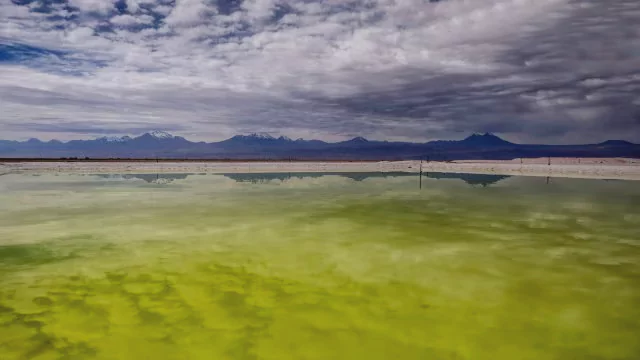Chile’s Atacama salt flat is sinking at a rate of 1 to 2 centimetres per year due to lithium brine extraction, according to a study by the University of Chile.
The most impacted region covers 8 km north to south and 5 km east to west in the southwest part of the salt flat, where lithium miners operate.
About Atacama Salt Flat

- The Atacama Salt Flat is the biggest salt deposit in Chile, covering 750,000 acres (300,000 km²).
- It has a rough white surface, with a large salt lake underneath.
-
Lithium and Wildlife
- Lithium Reserves: The salt flat is rich in lithium, a mineral used in technology. The lithium is mostly extracted from the southern part of the flat.
- Wildlife: There are lagoons formed by holes in the salt flat, which are home to various birds, including flamingos, coots, and guallatas.
Enroll now for UPSC Online Course
Atacama desert
- It is situated in northern Chile between the coastal Cordillera de la Costa mountains and the Andes Mountains.
- Its zone is called the “shadow of rain”.
- Known for : Driest nonpolar desert globally.
- Mars Mission: The desert’s barren and dry landscapes make it an ideal condition for a Mars mission.
- Climate: Its climate is extremely arid due to
- Cool Humboldt Current: A cold ocean current along the desert’s coast.
- Pacific Anticyclone: A high pressure system that inhibits moisture.
|
-
-
- Chaxa Lagoon: This lagoon is part of Los Flamencos National Reserve, 56 km south of San Pedro de Atacama.
- Features: The lagoon has floating blocks of salt and is a habitat for flamingos. It’s not suitable for swimming due to sharp rocks.
- Cejar Lagoon: Also part of Los Flamencos National Reserve, Cejar Lagoon has turquoise waters surrounded by white salt.
Causes of the Salt flat Sinking
- Over-Extraction of Lithium Brine
- Exceeding Recharge Rates: The rate at which lithium-rich brine is being pumped to the surface exceeds the natural recharge of aquifers.
- Subsidence: This imbalance leads to subsidence, or the sinking of the Earth’s surface.
- Impact on Aquifers
- Depletion: Excessive pumping depletes aquifers, reducing the water available for natural recharge.
- Disruption of Water Balance: This disruption of the water balance contributes to the sinking of the salt flat.
Environmental Impact of Lithium Mining
- Water Usage: The evaporation method used to produce lithium consumes large amounts of fresh water—approximately 2,000 tons of water are needed to produce one ton of lithium in the Atacama Desert.
- Impact on Communities and Wildlife: The overuse of water for lithium mining leaves indigenous communities and wildlife, like flamingos, with less water for their needs.
- Chemical Pollution: Lithium extraction uses harmful chemicals like sulfuric acid and sodium hydroxide, which pollute the soil and water, damaging ecosystems and threatening plant and animal life.
- Loss of Biodiversity: The decline in water levels and habitat degradation have led to a decline in wildlife populations, such as flamingos.
Check Out UPSC CSE Books From PW Store
About Lithium
- Lithium (symbol Li, atomic number 3) is a soft, silvery-white metal.
- It is the least dense metal and the least dense solid element under standard conditions.
- Highly reactive and flammable, lithium must be stored in controlled environments like a vacuum or in inert substances such as kerosene or mineral oil.
- Corrosion and Occurrence:
-
- Lithium exhibits a metallic luster but corrodes quickly when exposed to air, turning from silvery gray to a black tarnish.
- It does not naturally exist in its free form and is mainly found in minerals, particularly pegmatitic minerals.
- Due to its solubility, lithium is also present in ocean water and is primarily extracted from brines.
Applications of Lithium
- Lithium has various industrial uses, including in the production of heat-resistant glass and ceramics, lubricants, and as flux additives in iron, steel, and aluminum manufacturing.
- Lithium is also widely used in lithium metal and lithium-ion batteries, which account for over three-quarters of global lithium consumption.
- Biological Presence:
- Lithium is found in trace amounts in biological systems but has no known essential metabolic function in humans.
- Medical Use:
- Lithium-based medications are effective in treating mental health conditions, particularly as mood stabilizers and antidepressants in bipolar disorder.
|
![]() 26 Aug 2024
26 Aug 2024

